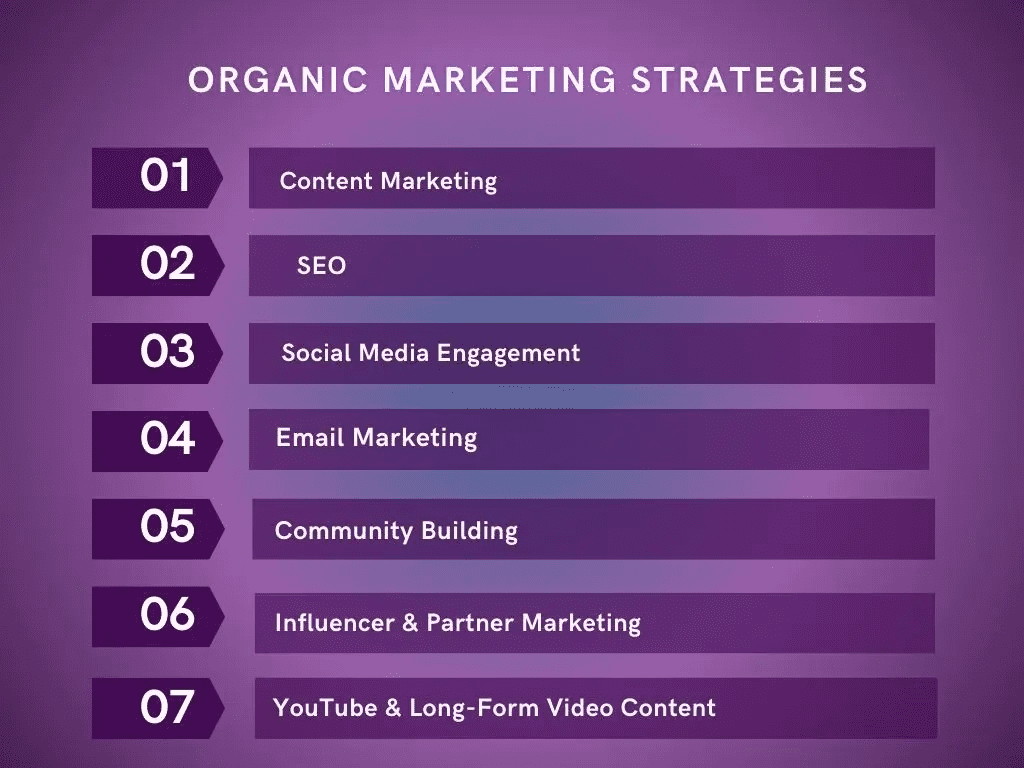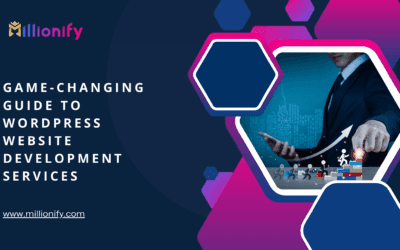Paid advertising costs are skyrocketing, and competition for attention is fiercer than ever. While ads can generate quick traffic, they disappear the moment you stop spending. Organic marketing, on the other hand, builds long-term visibility, trust, and brand authority—without a constant need for ad spend.
But how do you make organic marketing work in 2025? With shifting algorithms and evolving customer behaviors, you need a well-planned strategy. This guide will show you how to generate leads, boost brand awareness, and drive sales without relying on paid ads.
What is Organic Marketing?
Organic marketing refers to any strategy that attracts customers naturally over time, without paid promotions. It focuses on building a loyal audience through valuable content, engagement, and SEO rather than running ads.
| Organic Marketing | Paid Marketing |
|---|---|
| Free, long-term results | Requires continuous spending |
| Builds trust and brand authority | Works quickly but stops when you stop paying |
| Involves content, SEO, and engagement | Involves direct promotions and PPC |
| Strengthens customer relationships | Focuses on instant conversions |
Why Organic Marketing is the Future
- Trust & Authenticity: 81% of consumers trust organic content over ads.
- Cost-Effective: Once built, organic traffic keeps coming—unlike paid ads.
- Algorithm-Friendly: Google and social platforms reward valuable, engaging content.
Now, let’s explore the top organic marketing strategies you need in 2025!

1. Content Marketing: The Heart of Organic Growth
Content marketing is the most powerful organic marketing strategy because it attracts, educates, and converts customers without requiring paid ads. By consistently delivering high-quality content, businesses can establish themselves as industry authorities, build trust with their audience, and improve their SEO rankings.
How to Create High-Performing Content
✅ Blog Posts – Writing in-depth, informative blog posts helps attract organic traffic. Focus on long-form content (1,500+ words) that provides actionable solutions to your audience’s problems. Use SEO keywords naturally, add internal/external links, and break up text with subheadings, images, and bullet points.
✅ Videos & Reels – Video content is now the most consumed format online. Short-form videos on Instagram Reels, TikTok, and YouTube Shorts receive higher engagement. Create how-to videos, behind-the-scenes clips, product demos, or customer testimonials to connect with your audience.
✅ Infographics & Carousels – Visual content is 94% more engaging than text alone. Infographics simplify complex data, while carousel posts on LinkedIn and Instagram encourage users to scroll through multiple slides, boosting interaction and time spent on your content.
✅ E-books & Case Studies – Lead magnets like e-books, whitepapers, and case studies are excellent tools for capturing email leads. A well-structured case study showcasing a customer’s success story can significantly boost credibility and increase conversion rates.
💡 Pro Tip: Storytelling is the secret to memorable content. Facts inform, but stories connect emotionally with your audience. Use personal experiences, customer journeys, or real-life examples to make your content relatable and engaging.
Content Marketing Checklist
| ✅ Task | 🔥 Why It Matters |
|---|---|
| Research trending topics | Ensures relevance and audience interest |
| Use SEO keywords | Helps content rank higher on search engines |
| Add visuals (images, infographics) | Increases user engagement and shares |
| Write in a conversational tone | Makes content more approachable and easy to read |
2. SEO: Get Found on Google (Without Paying for Ads)
SEO (Search Engine Optimization) is the backbone of organic marketing. It allows your website to rank higher on search engines like Google, making it easier for potential customers to find you without paid ads. The best part? Once you rank, you get continuous free traffic!
Key SEO Tactics for 2025
✅ Keyword Research – Target high-intent keywords that match what users are searching for. Use tools like Google Keyword Planner, SEMrush, or Ahrefs to find low-competition, high-traffic keywords.
✅ On-Page SEO – Optimize every webpage by using:
- Title Tags – Make them keyword-rich and attention-grabbing.
- Meta Descriptions – Summarize content in 155-160 characters with a call to action.
- Headings (H1, H2, H3) – Organize content and include primary keywords.
- Internal Linking – Connect related pages to improve navigation and ranking.
✅ Quality Backlinks – Google prioritizes websites with strong backlinks (links from other credible sites). Get backlinks by:
- Guest blogging on reputable sites.
- Collaborating with influencers and industry leaders.
- Creating high-value, shareable content that naturally attracts links.
✅ Mobile Optimization – More than 60% of searches happen on mobile. Google now ranks mobile-friendly sites higher. Ensure your website has:
- Fast loading speeds (under 3 seconds).
- Responsive design that adapts to any device.
- Easy-to-read font sizes and clear CTAs.
SEO vs. Paid Ads: Which is Better?
| Feature | SEO (Organic Search) | PPC (Paid Search) |
|---|---|---|
| Cost | Free traffic (requires effort) | Pay per click (ongoing budget needed) |
| Longevity | Long-term traffic growth | Stops when budget runs out |
| Credibility | Builds trust over time | Users may distrust ads |
| Click-Through Rate (CTR) | Higher for organic results | Lower for paid ads |
💡 Pro Tip: SEO takes time, but once you rank, your website gets consistent, high-quality traffic without ongoing costs!
3. Social Media Engagement: Build an Audience Without Ads
Social media platforms have millions of active users daily, making them an essential part of any organic marketing strategy. The key to growing without paid ads is understanding how algorithms work—platforms prioritize engagement (likes, comments, shares, and saves) over everything else. By fostering authentic interactions, you can expand your reach without spending a dime on ads.
How to Grow Organically on Social Media
✅ Post Consistently – Consistency is crucial for algorithm visibility. Aim to post at least 3-5 times per week to keep your audience engaged and your profile active.
✅ Encourage Comments & Shares – Engagement signals tell the algorithm that your content is valuable. Ask questions in captions, create polls, or post controversial (but relevant) takes to spark conversations.
✅ Use Hashtags Wisely – Hashtags help your content get discovered, but using too many can hurt reach. Stick to 3-5 highly relevant hashtags instead of flooding your post with 30 generic ones.
✅ Go Live & Use Stories – Live videos and Stories receive higher priority in social media feeds because they create real-time engagement. Use them for behind-the-scenes looks, Q&A sessions, or product launches.
Top Social Media Platforms for Organic Growth
| Platform | Best For | Growth Strategy |
|---|---|---|
| Reels, Stories | Short-form video content, interactive polls, and collaborations | |
| B2B networking | Thought leadership posts, long-form articles, and professional discussions | |
| TikTok | Viral engagement | Trend-based content, challenges, and creative storytelling |
| YouTube | Evergreen video content | Long-form tutorials, reviews, and educational content |
💡 Pro Tip: User-generated content (UGC) boosts engagement. Encourage followers to share posts using your product or service and feature them on your profile!
4. Email Marketing: The Secret to Long-Term Customer Loyalty
Organic marketing isn’t just about attracting new customers—it’s about keeping them engaged. Email marketing is one of the most effective ways to nurture leads, build trust, and turn one-time buyers into lifelong customers.
How to Build an Email List Organically
✅ Offer a Lead Magnet – People won’t give their email for nothing! Provide an irresistible incentive such as:
- Free e-books
- Exclusive discounts
- Free courses or webinars
- Downloadable templates or checklists
✅ Create a Welcome Sequence – First impressions matter! When someone subscribes, don’t leave them hanging. Set up an automated welcome email series that:
- Introduces your brand’s story
- Offers valuable tips or insights
- Provides a special offer to encourage the first purchase
✅ Send Weekly Value-Packed Emails – Avoid spamming with promotions. Instead, balance content with a mix of:
- Industry updates
- Success stories
- Quick, actionable tips
- Personal stories that build brand connection
💡 Pro Tip: Personalization increases email open rates by 26%! Use the subscriber’s name, segment your audience, and tailor content to their interests.
5. Community Building: Turn Customers Into Advocates
The most successful brands don’t just sell products—they build communities. A strong community creates brand advocates who market your business for free by sharing their experiences and recommending you to others.
Ways to Build an Organic Community
✅ Facebook Groups – Create niche groups related to your industry where members can discuss trends, ask questions, and get advice. This fosters trust and loyalty.
✅ Exclusive Discord/Slack Channels – Provide VIP customers or followers with a private space to engage with your brand, discuss industry insights, and network with others.
✅ User-Generated Content (UGC) – Encourage customers to share testimonials, photos, and videos of your product or service. Featuring UGC on your social media or website builds authentic social proof.
Why Community Building Works
| Benefit of Community Building | Why It Works |
|---|---|
| Customers market for you | Word-of-mouth is one of the most powerful marketing tools |
| Higher engagement | People feel a sense of belonging and stay engaged with your brand |
| More trust & credibility | Social proof makes new customers feel more confident in choosing your business |
💡 Pro Tip: The best marketing doesn’t feel like marketing. When you create a community, customers naturally promote your brand without being asked!
6. Influencer & Partner Marketing: Leverage Authority for Organic Growth
Influencer and partner marketing are powerful organic strategies that help you tap into existing audiences without relying on ads. When a trusted industry expert, influencer, or partner endorses your brand, it builds instant credibility and increases your visibility.
How to Use Influencer & Partner Marketing for Organic Growth
✅ Collaborate with Micro-Influencers – While big influencers charge high fees, micro-influencers (1K–50K followers) often offer free or affordable collaborations. They have highly engaged audiences and are seen as more authentic.
✅ Guest Blogging & Podcast Features – Reach new audiences by writing guest posts for reputable blogs or appearing on industry-related podcasts. This positions you as an authority while driving organic traffic back to your website.
✅ Cross-Promotions with Other Brands – Partner with complementary businesses in your niche for joint promotions, giveaways, or co-hosted events. This way, you expose your brand to a new audience while providing value.
✅ Affiliate Partnerships – Create an affiliate program where content creators and influencers promote your product in exchange for a commission. This turns them into long-term organic marketers for your brand.
💡 Pro Tip: Authenticity matters! Always work with influencers or partners who genuinely align with your brand values. Audiences can spot inauthentic promotions from a mile away!
7. YouTube & Long-Form Video Content: The SEO-Boosting Powerhouse
YouTube isn’t just a social platform—it’s the second largest search engine in the world (after Google). Long-form video content on YouTube helps businesses rank for high-intent keywords, build credibility, and generate organic traffic for years.
How to Use YouTube for Organic Growth
✅ Create Evergreen Content – Focus on long-term value by producing:
- How-to guides & tutorials
- Industry insights & expert interviews
- Product walkthroughs & case studies
- Behind-the-scenes & brand storytelling
✅ Optimize Videos for SEO – Just like blog content, YouTube videos need SEO optimization:
- Use targeted keywords in video titles & descriptions.
- Add timestamps & chapters for better user experience.
- Include compelling thumbnails to improve click-through rates (CTR).
✅ Leverage YouTube Shorts – Short-form videos (60 seconds or less) are favored by YouTube’s algorithm and help new channels gain traction quickly.
✅ Repurpose Video Content – A single YouTube video can be turned into:
- Blog posts
- Short Instagram & TikTok clips
- Podcast episodes
- Email newsletters
💡 Pro Tip: Consistency is key! Posting one high-quality video per week can drive long-term, sustainable growth without spending on ads.
Final Thoughts: Why Organic Marketing is a Must for 2025
Organic marketing isn’t just a trend—it’s the most sustainable way to build brand authority, drive traffic, and grow a loyal customer base without spending thousands on ads.
Key Takeaways:
✅ Organic marketing builds trust and authority over time.
✅ SEO, content, social media, email, and community building work together.
✅ Consistency and engagement are crucial for success.
Want to grow your business organically? Start implementing these strategies today and watch your brand thrive!
FAQs
1. What is organic marketing?
Organic marketing refers to strategies that attract customers naturally without paid ads. It includes SEO, content marketing, social media engagement, email marketing, and community building.
2. How long does it take to see results from organic marketing?
Organic marketing requires consistency and patience. Typically, businesses start seeing noticeable improvements in 3-6 months, with long-term growth over 12+ months.
3. Is SEO still important in 2025?
Yes, SEO remains a crucial strategy for ranking higher on Google, driving free traffic, and building brand credibility without ad spend.
4. Can organic marketing replace paid advertising?
Organic marketing builds sustainable, long-term growth, but paid ads can be used alongside it for quick results. A combination of both is ideal for maximum impact.
5. What’s the best social media platform for organic growth?
The best platform depends on your audience. Instagram and TikTok work well for visual content, LinkedIn is great for B2B networking, and YouTube is ideal for long-form, evergreen videos.



